
- Home
- Travel Packages
- Top Destination
-
Travel Attraction
By Category
Top Attraction

- Travel Agents
- Car Rentals
- Hotels
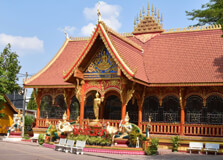
Located in the heart of Vientiane, the capital city of Laos, Wat Si Muang is one of the most important and popular temples in the country. The temple is not only a place of worship but also a significant cultural and historical site that attracts both locals and tourists alike. The temple's striking architecture, rich history, and spiritual significance make it a must-visit destination for anyone traveling to Laos. Architecture of Wat Si Muang Temple Wat Si Muang is known for its exquisite architecture that blends traditional Lao and French colonial styles. The temple features a stunning facade adorned with intricate carvings and colorful murals depicting scenes from Buddhist teachings. The main prayer hall, or sim, is an impressive wooden structure with a multi-tiered roof and intricate details that showcase the craftsmanship of local artisans. The temple grounds are also home to a beautiful garden filled with lush greenery and blooming flowers, creating a peaceful and serene atmosphere for visitors to explore and meditate. History Wat Si Muang holds great historical significance in Laos. According to legend, the temple was built on the site where a young woman named Si Muang sacrificed herself in order to protect the city from evil spirits. Her spirit is said to reside in the temple, granting blessings and protection to those who visit and pray at the shrine dedicated to her. Over the years, Wat Si Muang has become a place of pilgrimage for devotees seeking blessings for good fortune, health, and prosperity. Best Time To Visit The best time to visit Wat Si Muang is during the early morning or late afternoon when the temple is less crowded and the weather is more pleasant. The early morning light casts a golden glow over the temple, creating a magical atmosphere that is perfect for quiet reflection and meditation. If you visit during a festival or special religious event, you will have the opportunity to witness traditional ceremonies and rituals that showcase the vibrant culture and spiritual traditions of Laos. How To Reach Wat Si Muang is conveniently located in the city center of Vientiane, making it easily accessible by foot, bicycle, tuk-tuk, or taxi. If you are staying in a hotel or guesthouse in the city, you can simply take a leisurely walk to the temple and enjoy the sights and sounds of Vientiane along the way. For those coming from outside the city, there are regular bus services that connect Vientiane with other major towns and cities in Laos, making it easy to include a visit to Wat Si Muang in your travel itinerary. Significance Of The Wat Si Muang Temple Wat Si Muang holds a special place in the hearts of the people of Laos. The temple is not only a place of worship but also a cultural and spiritual center that plays an important role in the daily lives of locals. Devotees come to the temple to make offerings, light incense, and pray for blessings and protection from Si Muang. The temple's tranquil setting and sacred atmosphere provide a peaceful sanctuary where visitors can connect with their inner selves and experience a sense of peace and harmony. Whether you are a devout Buddhist or simply a curious traveler, a visit to Wat Si Muang is sure to leave a lasting impression and enrich your understanding of Lao culture and spirituality.
Explore More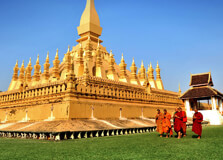
Great Sacred Stupa (Pha That Luang)
The Great Sacred Stupa, also known as Pha That Luang, is a prominent Buddhist monument located in Vientiane, the capital city of Laos. It was originally built in the 3rd century by the Khmer King, and has undergone several renovations over the centuries. The current structure was reconstructed in the 1930s, following French colonial rule. Architecture and Design The Great Sacred Stupa features a stunning gold-covered stupa, surrounded by smaller stupas, statues, and ornate carvings. The main stupa stands at 45 meters tall, symbolizing the Buddhist principles of enlightenment and unity. Best Time to Visit The best time to visit the Great Sacred Stupa is during the annual That Luang Festival, which takes place in November. This vibrant celebration includes traditional music, dance, and religious ceremonies, making it an ideal time to experience the cultural significance of the monument. Cultural Significance Pha That Luang holds great cultural significance for the people of Laos, serving as a symbol of national pride and unity. It is considered the most important religious monument in the country, attracting pilgrims and tourists alike who come to pay their respects and admire its beauty. Pilgrimage Practices Many Buddhist pilgrims visit Pha That Luang to offer prayers, make offerings, and participate in rituals that are believed to bring blessings and good luck. Pilgrims often walk around the stupa in a clockwise direction, while chanting mantras and performing other devotional practices. Dress Code and Etiquette Visitors to the Great Sacred Stupa are advised to dress modestly, covering their shoulders and knees out of respect for the sacred site. It is also customary to remove shoes before entering the temple grounds, and to maintain a quiet and respectful demeanor while on the premises. Activities and Experiences Aside from paying homage to the stupa, visitors can explore the surrounding temple complex, which includes statues, gardens, and meditation areas. The on-site museum offers insights into the history and cultural significance of Pha That Luang, providing a comprehensive experience for those interested in Buddhist art and architecture. Art and Religious Symbols The intricate carvings, statues, and decorations found throughout Pha That Luang are rich in symbolism and religious significance. Images of the Buddha, lotus flowers, and mythical creatures adorn the walls and structures of the stupa, conveying messages of enlightenment, purity, and protection. Local Insights Local residents hold Pha That Luang in high regard, viewing it as a sacred place of worship and a symbol of national identity. Many Laotians visit the stupa regularly to offer prayers, meditate, and seek blessings for themselves and their loved ones. The monument plays a central role in the cultural and spiritual life of the country, reflecting the deep-rooted beliefs and traditions of its people.
Explore More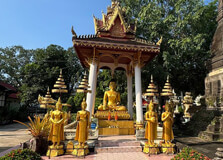
Wat Si Saket Temple, located in Vientiane, Laos, is one of the oldest and most significant Buddhist temples in the country. Built in 1818 by Chao Anou, the last monarch of the Lan Xang Kingdom, this temple is renowned for its unique architecture and historical significance. Architecture of Wat Si Saket Temple The architecture of Wat Si Saket Temple is a beautiful blend of Lao and Thai styles. The complex consists of a main hall, a cloister, and a surrounding veranda adorned with thousands of Buddha images. The main hall features a three-tiered roof and intricately carved wooden doors, while the cloister houses numerous niches containing small Buddha statues. History Wat Si Saket Temple was built to house sacred Buddhist relics and manuscripts that were brought from the ancient capital of Ayutthaya. The temple served as a royal temple and was used by the royal family for important ceremonies and rituals. During the Siamese invasion of Vientiane in 1828, Wat Si Saket Temple was one of the few structures that remained intact, making it a significant historical landmark in Laos. Best Time To Visit The best time to visit Wat Si Saket Temple is during the early morning or late afternoon when the temperatures are cooler and the light is perfect for photography. The temple is open to visitors from sunrise to sunset, so plan your visit accordingly to avoid the crowds and experience the peaceful atmosphere of this sacred site. How To Reach Wat Si Saket Temple is located in the heart of Vientiane, the capital city of Laos. The temple is easily accessible by tuk-tuk, taxi, or even on foot from most parts of the city. If you are staying in the city center, you can walk to the temple in less than 30 minutes. Alternatively, you can hire a tuk-tuk or taxi to take you directly to the temple entrance. Significance Of The Wat Si Saket Temple Wat Si Saket Temple is not only a religious site but also a cultural heritage symbol of Laos. The temple houses thousands of Buddha images, manuscripts, and artifacts that reflect the rich history and traditions of the country. It is a place of worship, meditation, and learning, attracting visitors from around the world who come to admire its beauty and soak in its spiritual ambiance. Overall, Wat Si Saket Temple is a must-visit destination for anyone traveling to Vientiane. Its unique architecture, historical significance, and cultural importance make it a fascinating place to explore and learn about the rich Buddhist heritage of Laos.
Explore More
The Black Stupa, also known as That Dam, is a historic monument located in Vientiane, the capital city of Laos. The exact origins of the stupa are unknown, but it is believed to have been built in the 16th century. It has survived various invasions and wars over the centuries, making it a symbol of resilience and endurance for the people of Laos. Architecture and Design The Black Stupa is a unique structure made of blackened stone, giving it a distinctive appearance. Its design is simple yet elegant, with intricate carvings and details that showcase the craftsmanship of the artisans who built it. The stupa stands tall and majestic, serving as a focal point in Vientiane's skyline. Best Time to Visit The best time to visit the Black Stupa is during the dry season, which typically runs from November to March. This period offers pleasant weather with cooler temperatures, making it ideal for exploring the monument and its surroundings. Avoid visiting during the wet season, as heavy rains can make the area muddy and difficult to navigate. Cultural Significance The Black Stupa holds significant cultural importance for the people of Laos. It is considered a sacred site, where locals come to pay their respects and offer prayers. The stupa is also a symbol of protection and good fortune, with many believing that it brings blessings to those who visit and pay homage to it. Pilgrimage Practices Visitors to the Black Stupa are encouraged to participate in the local pilgrimage practices, which involve walking clockwise around the stupa while reciting prayers or mantras. This ritual is believed to bring good luck and blessings to those who partake in it. It is a unique and spiritual experience that allows visitors to connect with the cultural and religious traditions of Laos. Dress Code and Etiquette When visiting the Black Stupa, it is important to dress modestly and respectfully. This means covering your shoulders and knees, and avoiding revealing clothing. It is also customary to remove your shoes before entering the stupa grounds as a sign of respect. Remember to maintain a quiet and reverent demeanor while on the premises, as the stupa is a place of worship for many locals. Activities and Experiences Visitors to the Black Stupa can engage in a variety of activities and experiences during their visit. This includes exploring the surrounding gardens and grounds, where you can enjoy a peaceful stroll and take in the serene atmosphere. You can also participate in meditation or yoga sessions offered at the stupa, allowing you to connect with your inner self and find inner peace. Art and Religious Symbols The Black Stupa is adorned with various art and religious symbols that hold deep significance for the people of Laos. These symbols include intricate carvings of Buddha and other deities, as well as ancient inscriptions that tell stories of the stupa's history and cultural relevance. Visitors can marvel at the craftsmanship and attention to detail displayed in the stupa's design, making it a truly awe-inspiring sight to behold. Local Insights For a unique and authentic experience, consider seeking out local insights about the Black Stupa from residents of Vientiane. Locals can provide valuable information about the stupa's history, significance, and cultural practices, allowing you to gain a deeper understanding of this sacred site. Engaging with locals also provides an opportunity to learn more about Laotian culture and traditions, enriching your visit to the Black Stupa and enhancing your overall travel experience in Vientiane.
Explore More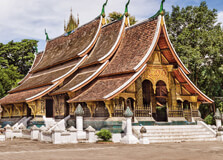
Wat Xieng Thong, often considered the crown jewel of Luang Prabang’s temples, is one of the most significant and beautiful Buddhist monasteries in Laos. Located in the UNESCO-listed city of Luang Prabang, this temple is a vital symbol of the rich cultural and religious heritage of the region. Established in the 16th century, Wat Xieng Thong remains one of the best-preserved examples of traditional Lao architecture, featuring intricate carvings, stunning mosaics, and a serene atmosphere. How to Reach Wat Xieng Thong, Luang Prabang Wat Xieng Thong is centrally located within Luang Prabang, making it easy to reach from most parts of the city. Here are some ways to get there: Walking: If you're staying in the city center, Wat Xieng Thong is within walking distance from most of the hotels, restaurants, and other attractions. It's a pleasant 10-minute walk from the Royal Palace Museum. Tuk-Tuk: If you're farther from the center, you can take a tuk-tuk to the temple. A ride typically costs around 20,000 to 30,000 LAK (Lao Kip), depending on where you're coming from. Bicycle: Renting a bicycle is a great way to explore Luang Prabang. Many local bike rentals offer affordable rates, and biking around the city is both fun and convenient. Weather and Timing Luang Prabang has a tropical climate, so the best time to visit Wat Xieng Thong depends on the season: Dry Season (November to April): This is the most popular time to visit, with clear skies and moderate temperatures (ranging from 25°C to 35°C or 77°F to 95°F). The dry weather makes walking and sightseeing more comfortable, and the temple’s intricate features are more visible. Rainy Season (May to October): The rainy season brings heavy showers, especially in July and August. While the temple is still accessible, the rain might make the paths slippery and less comfortable. However, if you're visiting during this time, you’ll experience fewer tourists and lush, green landscapes. Best Timing to Visit Wat Xieng Thong The temple is open daily, and the best times to visit are early in the morning, around sunrise, or late in the afternoon before sunset. These times not only provide a peaceful and serene atmosphere but also allow visitors to witness the temple’s stunning architecture under the soft, golden light of the day. Early mornings are especially calm, making it an ideal time for photography or meditation. Why Wat Xieng Thong is Famous Wat Xieng Thong is famous for many reasons, with its historical significance, architectural beauty, and religious importance standing out. Here’s why this temple is one of the most celebrated landmarks in Laos: Historical Importance: Wat Xieng Thong was built in 1560 by King Setthathirath, and it has played a central role in the cultural and religious life of Luang Prabang. The temple has witnessed countless royal ceremonies and Buddhist festivals. Architectural Masterpiece: The temple’s architectural style is considered the finest example of traditional Lao religious architecture. The layout features a series of ornate buildings, golden mosaics, and delicate carvings. The golden-roofed main hall is a striking feature, while the intricate murals depicting scenes from Buddhist mythology are another major draw. Religious Significance: Wat Xieng Thong is a living temple, meaning it continues to serve as a place of worship and meditation. It is one of the most important pilgrimage sites for Buddhists in Laos. Entry and Visit Details about Wat Xieng Thong Visiting Wat Xieng Thong requires a small entry fee of around 20,000 LAK (approximately $2 USD). The temple is open daily from 8:00 AM to 5:00 PM, and it is recommended to visit during the cooler hours of the morning or late afternoon to avoid the heat. As a sacred site, visitors are advised to dress modestly. This means wearing clothing that covers your shoulders and knees. Removing your shoes before entering the temple buildings is also a sign of respect. History and Architecture of Wat Xieng Thong Wat Xieng Thong is one of the oldest and most important temples in Laos, with a history that dates back to the 16th century. It was built during the reign of King Setthathirath, and its purpose was to serve as a royal temple for the Lao kings. The temple has survived numerous invasions and natural disasters, maintaining its cultural and religious significance throughout the centuries. Architecturally, Wat Xieng Thong is a true masterpiece of traditional Lao design. The temple complex consists of a main hall (sim), smaller pavilions, a tower, and a library. The main hall is particularly famous for its golden roof and beautifully crafted doors. The temple’s walls feature elaborate carvings and mosaics depicting various scenes from the life of the Buddha. Things to Do at Wat Xieng Thong Admire the Architecture: Take time to explore the temple’s stunning design. From the golden roof to the intricate carvings on the walls, Wat Xieng Thong is a treasure trove of artistic and architectural beauty. Learn About Lao Buddhism: The temple offers an excellent opportunity to learn about the traditions and practices of Lao Buddhism. You can observe monks at prayer, meditate, or simply reflect in the peaceful surroundings. Photography: Wat Xieng Thong is one of the most photographed landmarks in Luang Prabang. Whether you’re interested in capturing the grand architecture, the vibrant murals, or the serene atmosphere, the temple offers plenty of opportunities for beautiful shots. Explore the Surroundings: The temple is located near the Mekong River, so take a stroll around the surrounding area for beautiful views of the river and the city. There are also several other temples nearby that are worth visiting. Facts and Tips about Wat Xieng Thong Wear Modest Clothing: As a religious site, visitors are expected to dress modestly. Avoid wearing shorts, sleeveless tops, and sandals. Long pants or skirts and covered shoulders are recommended. Best Time for Photography: The best time for photos is early morning or late afternoon, when the light is soft and the temple is less crowded. Respect the Sacred Site: Wat Xieng Thong is an active temple, so be sure to show respect. Speak quietly, and avoid disturbing the monks or other visitors who may be meditating or praying. Check for Events: The temple is often used for religious ceremonies, so it’s worth checking if there are any special events or festivals during your visit. Explore the Museum: The temple complex also features a small museum where you can learn more about the history of Wat Xieng Thong and the region’s Buddhist culture.
Explore More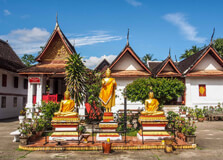
Wat Mai Suwannaphumaham, often simply referred to as Wat Mai, is one of the most significant and architecturally stunning Buddhist temples in Luang Prabang, Laos. Located at the heart of this UNESCO World Heritage city, it is known for its historical significance, intricate design, and cultural value. Whether you are a history enthusiast, a spiritual traveler, or someone who appreciates beautiful architecture, Wat Mai is a must-visit destination. How to Reach Wat Mai Suwannaphumaham, Luang Prabang Wat Mai Suwannaphumaham is centrally located in Luang Prabang, making it easily accessible for both locals and tourists. Here are the best ways to reach the temple: By Foot: If you are staying in the town center, walking to Wat Mai is the most convenient option. The temple is located near the Royal Palace Museum, which is a central landmark in the city. The walk is short and offers the chance to explore the charming streets of Luang Prabang. By Tuk-Tuk or Taxi: If you are staying further out or prefer a ride, tuk-tuks and taxis are readily available in Luang Prabang. Simply ask the driver to take you to Wat Mai, and the journey will take just a few minutes from most accommodations in the city. By Bicycle: Many visitors rent bicycles to explore the city, and this can be a pleasant way to reach Wat Mai while taking in the local sights. There are numerous bike rental shops in Luang Prabang, and most areas of the city are bike-friendly. Weather and Best Time to Visit Wat Mai Suwannaphumaham The weather in Luang Prabang is typically tropical, with a distinct wet and dry season. Here’s a breakdown of what to expect: Dry Season (November to April): The best time to visit Wat Mai is during the dry season, when temperatures are warm but not excessively hot. The weather is generally clear and sunny, making it ideal for exploring the temple and surrounding areas. Rainy Season (May to October): During the rainy season, the area experiences heavy showers, which can make outdoor activities less comfortable. However, the lush greenery and reduced crowds offer a quieter and more peaceful experience at the temple. Why Wat Mai Suwannaphumaham is Famous Wat Mai Suwannaphumaham is one of the most famous temples in Luang Prabang due to its unique architectural style and historical significance. Here are the reasons why this temple stands out: Rich Cultural Heritage: The temple has a long history, dating back to the 18th century, when it was originally built during the reign of King Surinyavong. It has since become a symbol of Lao Buddhism and culture, playing a vital role in religious and cultural ceremonies in the region. Impressive Architecture: The temple's design reflects the traditional Lao style of architecture, with intricately carved wooden elements, a gilded façade, and beautiful roof decorations. Its golden color and stunning structure make it one of the most photographed temples in Luang Prabang. Historical Significance: Wat Mai served as the residence of the Supreme Patriarch of Laos, making it a focal point for religious activities. It also housed the revered Emerald Buddha for a period of time, adding to its importance in Lao history. Entry and Visit Details about Wat Mai Suwannaphumaham Visiting Wat Mai Suwannaphumaham is a rewarding experience, and it is open to the public. Here are the details you need to know before visiting: Opening Hours: Wat Mai is generally open to visitors from 8:00 AM to 5:00 PM daily. However, visitors are advised to check for any special events or religious ceremonies, as these may affect the hours of operation. Entry Fee: There is typically no entry fee to visit Wat Mai, although donations are welcomed. The temple is primarily a place of worship, so donations help in maintaining the temple and supporting local monks. Dress Code: As with most Buddhist temples, visitors are asked to dress modestly. This means covering shoulders and knees, and removing shoes before entering the temple hall. History and Architecture of Wat Mai Suwannaphumaham Wat Mai Suwannaphumaham was originally constructed in the 18th century and underwent several renovations and expansions throughout the years. The temple was designed in the classic Lao style with a sweeping, multi-tiered roof, creating a striking silhouette against the sky. One of the most stunning features of the temple is its gilded façade, which is adorned with intricate carvings and designs. Inside, you’ll find beautiful murals and sculptures depicting scenes from Buddhist teachings and Lao history. The temple complex also includes a beautiful courtyard, a large prayer hall, and the famous golden statue of the Buddha. The temple is a hub for religious activity and hosts regular ceremonies, including important Buddhist holidays such as Lao New Year and the end of Buddhist Lent. Things to Do at Wat Mai Suwannaphumaham When you visit Wat Mai, there are several activities and experiences that will make your visit special: Admire the Architecture: Spend time appreciating the intricate architectural details of the temple. The golden façade, carvings, and beautiful rooflines are truly stunning and are perfect for photography. Explore the Courtyard: Walk around the serene temple courtyard, where you can find statues, flowers, and peaceful gardens that enhance the tranquil atmosphere of the site. Learn About Buddhism: Take the opportunity to learn more about Lao Buddhism and the history of Wat Mai by speaking with local monks or guides. This will provide insight into the spiritual significance of the temple. Attend a Ceremony: If your visit coincides with a local Buddhist ceremony, it’s a great opportunity to observe traditional rituals and learn more about the religious practices of the Lao people. Facts and Tips About Wat Mai Suwannaphumaham Photography: Photography is allowed at Wat Mai, but be respectful when taking photos inside the temple hall. Avoid flash photography, as it can disturb the monks and the sacred space. Best Time to Visit: Early mornings or late afternoons are the best times to visit Wat Mai, as the weather is cooler and the temple is less crowded. You can also witness the monks’ morning alms procession in the early hours. Respect the Local Culture: While visiting the temple, remember that it is a place of worship. Be respectful of the local customs, such as not pointing your feet at religious statues and sitting in a respectful position during ceremonies. Take Your Time: Spend time quietly reflecting and appreciating the spiritual atmosphere of the temple. Wat Mai offers a peaceful retreat from the busy streets of Luang Prabang.
Explore More